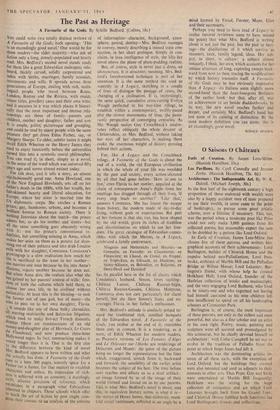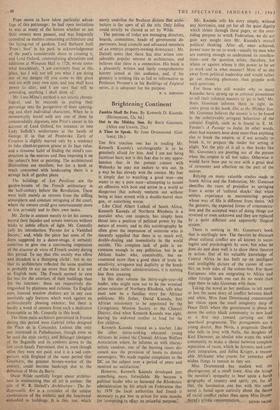0 Saisons 0 Chateaux
Earls of Creation. By James Lees-Milne. (Hamish Hamilton, 35s.) Les Pavilions. By Cyril Connolly and Jerome Zerbe. (Hamish Hamilton, 73s. 6d.) Architecture : The Indispensable Art. By W. R. Dalzell. (Michael Joseph, 30s.)
IN the first half of the' eighteenth century a high proportion of those 'endowed with wealth were also by a happy accident men of taste prepared to use their wealth, in some cases to the point of bankruptcy, to pursue some great artistic scheme, over a -lifetime if necessary. This, too, was the-period when a moderate poet like Prior could not only make 3,000 guineas from his collected poems, but reasonably expect the sum to be doubled by a patron like Lord Oxford.
In Earls of Creation, James Lees-Milne has chosen five of these patrons and written bio- graphical accounts of their achievements: Lord Burlington, builder of Chiswick House and the impulse behind neo-Palladianism; Lord Pem- broke, architect of Marble Hill and the Palladian Bridge at Wilton Blouse; Lord Leicester, Bur- lington's friend, with whose help he created Holkham Hall; Lord Oxford, founder of the Harleian collection of books and manuscripts; and the very engaging Lord Bathurst, who lived to be ninety-one and who Tegretted not having had himself castrated as his nine children left him insufficient to spend on all his landscaping schemes at Cirencester Park.
Burlington is, of course, the most important of these patrons, not only as the richest and most powerful, but also as a fine scholar and an artist in his own right. Poetry, music, painting and sculpture were all assisted and promulgated by this aristocrat, but he chiefly devoted himself to architecture: with Colin Campbell he set out to evolve in the tradition of Palladio from The point at which I nigo Jones had left it.
Architecture was the dominating artistic in- terest of all these earls, with the exception of Lord Word, but the buildings they created were also intended and used as adjuncts to their interests in other arts. Thus Pope, Gay and Swift were entertained at Marble Hill frequently; Holkham was the setting for the huge collection of antiquities and art which Lord Leicester brought back from his Grand 'Iour: and Chiswick House fulfilled both functions for Lord' Burlington's friends and collections.
Pope seems to have taken particular advan- tage of this patronage: he had open invitations to stay at many of the houses whether or not their owners were present, and was frequently consulted on matters concerning architecture and the laying-out of gardens. Lord Bathurst built 'Pope's Seat' in his park in acknowledgement of the poet's considerable share in creating it, and Lord Oxford, contemplating alterations and additions at Wimpole Hall in 1726, wrote some- what breathlessly, 'I am extremely busy at this place, but 1 will not tell you what I am doing nor of my designs till you come to this place and see with your own eyes; and you shall have power to alter, and I am sure that will be amending, anything I shall think of.'.
Mr. Lees-Milne's method is not strictly chrono- logical, and he succeeds in putting their patronage into the perspective of their upbring- ing and their individual characters. When he is momentarily bored with any one of them he commendably digresses, into Prior's career in his account of Lord Oxford, for instance, or into Lady Suffolk's misfortunes at the hands of George II in that of Pembroke. Earls of Creation is slightly marred only by a tendency to take client-to-patron praise at its face value, and a tiresome habit of finding the mind's con- struction in the sources and then imposing it on the subject's bust or painting. The architectural illustrations are excellent, but for a book so much concerned with landscaping there is a strange lack of garden plans.
The buildings of Les Pavilions are the garden-houses of the French aristocracy in the half-century before the Revolution. These were built mainly as retreats from the stifling atmosphere and constant intriguing of the court, where the owners could give entertainment more or less privately and to their own tastes.
Mr. Zerbe is content merely to let his camera record their façades and ornate interiors without tricks or subtle effects of light. Mr. Connolly calls his introduction 'Pavane for a Vanished Society,' and, while the piece has none of the form suggested by a dance-image, it certainly contrives to give one a convincing impression of the douceur de vivre of French society during this period. To say that this society was effete and decadent is a thumping cliche: but to say that its architecture reflected the same qualities is probably to say no more than that it is not to English taste. The French seemed to care far less for the exteriors of their buildings than for the interiors: these are respectively dis- tinguished by plainness and richness. To English eyes, louvred window shutters are in any case inevitably ugly features which work against an architecturally pleasing exterior; but there is hardly a word of censure from such a dedicated francophile as Mr. Connolly in this book.
The three main architects patronised in France during this period were Gabriel (who designed the Place de la Concorde), Ledoux (the only one interested in Palladianism, though even so he used the style rarely), and Belanger (designer of the Bagatelle and its contents down to the last clock-hand). Patronised, that is, even though often they were not paid; and it is a sad com- parison with England of the same period that Gouthiere, the greatest bronze-worker of the century, could- become bankrupt due to the defection of Mme du Barry.
Oscar Wilde carefully forgot about architec- ture in maintaining that all art is useless: the title of W. R. Dalzell's Architecture : The In- dispensable Art is a reminder of the unique combination of the aesthetic ,and the functional embodied in buildings. It is this, too, which surely underlies the Bauhaus dictum that archi- tecture is the apex of all the arts. Only follies could strictly be classed as art by Wilde.
The patrons of today are managing directors, boards, committees, heads of government de- partments, local councils and advanced members of an embryo property-owning democracy: Mr. Dalzell notes that there has also arisen con- siderable popular interest in architecture, and believes that there is a connection. His book is a pleasantly written and fairly comprehensive history aimed at this audience, and, if his glossary is nothing like as full or informative as Professor Pevsner's in his Buildings of England series, it is adequate for his purpose.
B. S. JOHNSON































 Previous page
Previous page